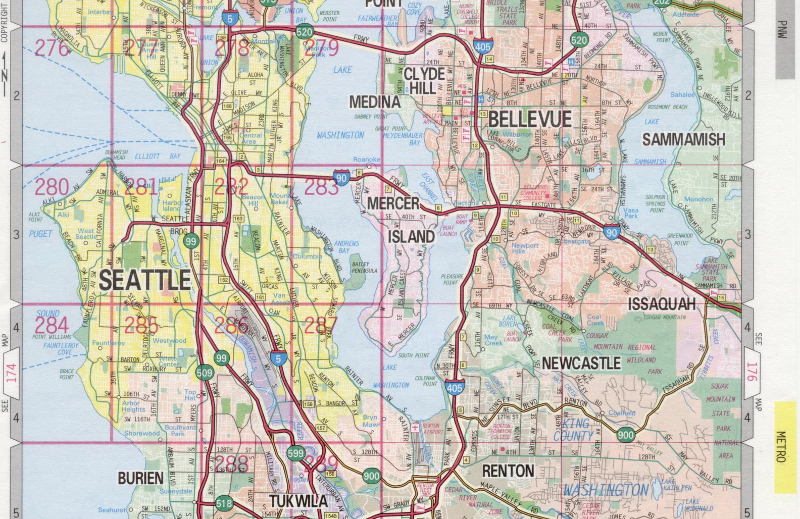

Puget Sound Indexer
With the announcement that the West Seattle Bridge will be closed indefinitely, and with the prospect of a drawn-out reopening of the economy from the coronavirus shutdown, tens of thousands of commuters will need to make an adjustment. The Mayor has indicated that expanded transit service is in the offing, but to what degree is that a feasible option for West Seattle commuters?
Data from the Census Bureau gives us some idea of normal commuter patterns, so we can imagine how transit might fit into their futures. As part of its Longitudinal Employer-Household Dynamics (LEHD) program, Census matches home addresses (via IRS tax returns) with work addresses (via unemployment insurance filings) to provide estimates of commutes. This data have some important limitations, discussed at the end of the article, but give a pretty good overall picture of commutes.
Figure 1 shows the destinations of commuters by the four zip codes of West Seattle. “Downtown Seattle” includes the zip codes 98101, 98102, 98104, 98109 and 98121, covering the downtown core and South Lake Union. Yesler Street divides north and south Seattle (outside Downtown), and West Seattle consists of the four zip code areas shown.


Figure 2 illustrates the breakdown of the total of commuters from West Seattle.

Only about 7 percent of commuters identified in the LEHD data stay in West Seattle. Another 28 percent commute to Downtown Seattle, which is easily served by transit. The remaining 65 percent of commuters head to areas that will be more challenging to serve conveniently with public transit.
About 1,500 people head from West Seattle to the University District, and a transfer to Link light rail may work well for some of those commuters. About 1,550 people commute to Downtown Bellevue, which has regular service after a transfer in Downtown Seattle.
Currently, most West Seattle residents commute by car. Figure 3 shows the breakdown of commute modes, from the Census Bureau’s American Community Survey 5-year averages. (The error margins are fairly large for the lesser-used modes like walking and biking). This data is for the Census Bureau’s public use microdata area (PUMA) that includes West Seattle as well as Beacon Hill.

Two thirds of employed West Seattle residents go to work in a car, and most drive alone. 20 percent of West Seattle commuters take transit, which is just about the citywide average. Unfortunately, this data does not tell us where those transit riders are currently headed.
Adding major transit capacity for West Seattle will be costly. For 2017, Metro reported the average cost to the system of a single bus trip at $5.15. Bus fares are currently $2.75, so Metro subsidizes the average trip to the tune of $2.40. At this rate, doubling transit ridership from West Seattle would cost about $10 million per year. It is likely, however, that bus occupancy would be much higher than average, and therefore service cost per trip would be lower. At the same time, many of these new transit riders will need to transfer, and will pay not additional fare for that trip.
The question is, would current car commuters find a transit ride better than sitting in what promises to be really bad traffic leaving West Seattle via one of the few ways to cross the Duwamish River? Metro’s trip planner shows a morning bus trip from the West Seattle Junction to the Bellevue Transit Center of 78 minutes, including a 10 minute transfer time. Google Maps shows a 32 minute car trip to Bellevue, without traffic, by way of the First Avenue South Bridge. So, the question becomes, if buses have access to the low-level West Seattle bridge, will the bus trip be competitive with a car trip in the nasty traffic that will clog the First Avenue South bridge route?
The Mayor said that coping with the bridge closure will require creativity. That may be an understatement.
Note on the LEHD data: This census program matches, for individual workers, the workplace address shown on their unemployment insurance (UI) filings with their home address as shown on their IRS tax return. While this data is invaluable, it does have certain limitations. First, it includes only those workers who are covered by unemployment insurance, and therefore excludes self-employed workers and uniformed military personnel. Self-employed workers can be up to 10 percent of the workforce. Second, while employers are required to list the actual worksite of each employee on their UI filings, some employers simply use a headquarters address. Census has no way of knowing when this happens, so some “commutes” will be inaccurate. Third, some workers may work at home or a remote or field site, and not commute to the location shown on their UI filing.
This article originally appeared in The Puget Sound Indexer
Discover more from Post Alley
Subscribe to get the latest posts sent to your email.

Michael,
This is a great detailed analysis. I encourage you to send it to each of the City and Council Members, and the city’s demographer. Sorry I do not have that person’s name handy.
Where is Capt. Rolf Neslund when we need him? (Alas, his bones lie moldering under his kitchen floor.) And where is Sen. Magnuson when we need him?
Really enjoyed this post and the analysis, some of the best I’ve seen on the bridge so far. More data driven results on the effects of the closure would be great! Would be really neat to calculate the predicted effects on home prices in west Seattle.
Great reporting! I plan to reference it in a post on the West Seattle Blog.